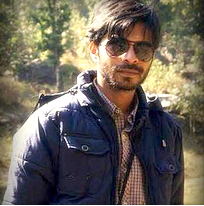Last Updated: May 13, 2019 Swairik Das
Known for its royal ambiance and colorful history ripe with stories of chivalry and valiance, Rajasthan is dotted with several tourist destinations that still hold a diorama of the medieval clamour. This incredible state in India, since time immemorial, has been invaded and ruled by several dynasties BUT couldn’t damage the princely status of the Rajput and Jat rulers. Rajasthan is widely known for its imposing architectural buildings, including forts, palaces, havelis and temples those built by the Rajputs and Jats. Most of these massive structures date back to the medieval era… of which few have been converted into government edifices and heritage hotels AND few have been retained as private residences of the royal family.
Here is a list of 30 forts and palaces that you must visit on your trip to Rajasthan:
1. Amber Fort and Palace, Jaipur
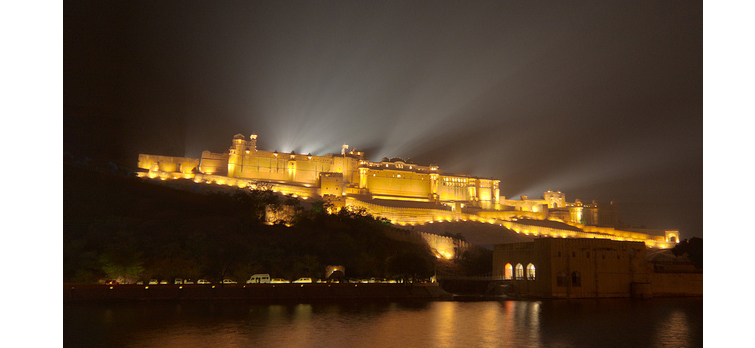
Located on the foot of the Aravalli range and overlooking the Maota Lake, the Amber (Amer) Fort is famed for its artistic craftsmanship that is laid on a four level layout. It is one of the best places to visit in Jaipur and is a fine example of red sandstone and marble architecture comprising the Hall of Public Audience, Hall of Private Audience, Sheesh Mahal and Sukh Niwas. Built in the 16th century by Raja Man Singh I, the Amber Fort within its ramparts holds a rich blend of Hindu elements including several gates and cobbled paths and the Sheela Mata Temple. Today the Amber Fort arrests the mind of millions of travellers from all over the world and the major tourist attraction remains the light and sound show that is held at Kesar Kyari inside Amber Fort every evening. Another mind-blogging display that you shouldn’t miss is when the fort is drenched in honey-gold at sundown.
2. Jaigarh Fort, Jaipur
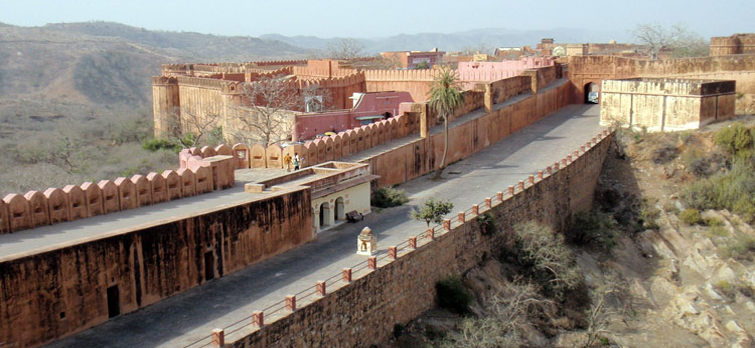
Often dubbed as Victory Fort, the Jaigarh Fort was built in 1726 by Jai Singh II to protect the Amber Fort, which lies on the foot of the Cheel Ka Teela. One of the most important features of the fort is the grand cannon, “Jaivana”, which was then the world’s largest cannon on wheels. The fort is crafted with a complex network of subterranean passages and comprises the Laxmi Vilas, Lalit Mandir, Vilas Mandir and Aram Mandir. Today the fort museum displays a wide range of antiques and armours belonging to several Rajput clans.
3. Nahargarh Fort, Jaipur
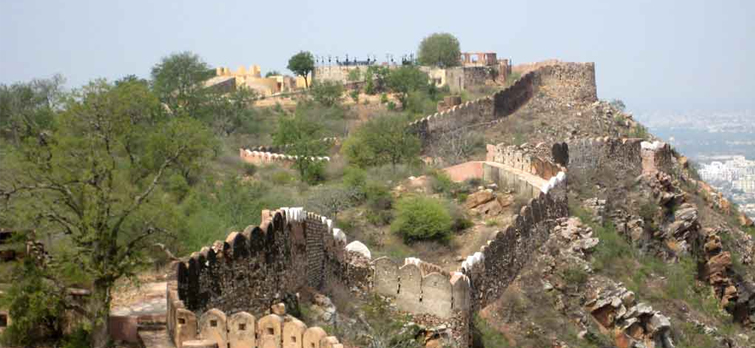
Overlooking the pink city of Jaipur, the Nahargarh Fort is perched on the edge of the Aravalli Hills. Built in 1734 as a summer retreat by Maharaja Sawai Jai Singh II… the fort was later extended by Sawai Ram Singh in 1868 and between 1883 and 1892 several palaces, including the Madhavendra Bhawan, were ramped up by Sawai Madho Singh. The extended walls of the fort connect the Jaigarh Fort. Throughout its history the fort maintained its lifelike structure as it never witnessed any attacks BUT was an hideaway to the British army during the Indian Rebellion of 1857 (Indian Sepoy Mutiny OR Indian Mutiny of 1857). Today it is one of the favourite tourist hangouts in the outskirts of Jaipur with the major attraction being the panoramic view of the Jaipur city and the step well. Within the fort complex there is a museum that displays a huge collection of armours and paintings. It also maintains a small rooftop restaurant where you can chill out for long hours.
4. Hawa Mahal, Jaipur
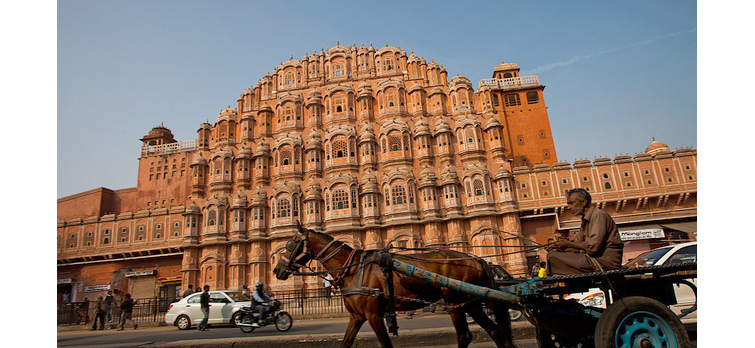
Located in the heart of the bustling city of Jaipur, the Hawa Mahal is one of the prominent historical landmarks in India that reveal a rich cultural and architectural heritage with a fusion of Rajasthani style of architecture and the Islamic Mughal architecture. Built in the 18th century by Maharaja Sawai Pratap Singh… it is an excellent work of red and pink sandstone famous for its high screen wall, which looks like a honeycomb web of a beehive, with several windows for the women of the royal household who could observe street festivities while unseen from the outside. The Hawa Mahal or the Palace of Winds comprises more than a thousand windows decorated with intricate latticework, rooms inlaid with colourful marbles, domed canopies, fluted pillars having lotus and floral patterns, and a courtyard that now houses a museum.
5. City Palace, Jaipur
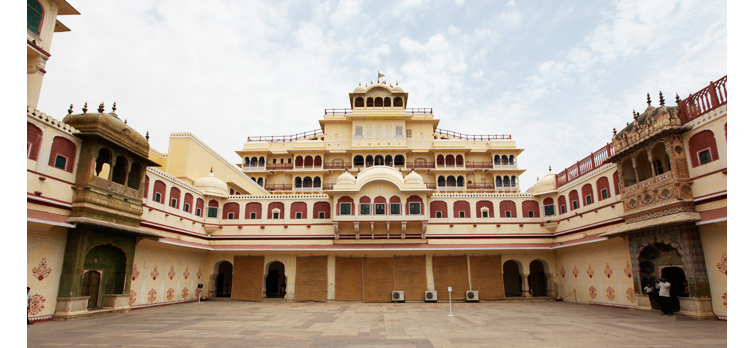
With a fusion of the typical Rajasthani style of architecture, Mughal architecture and European architecture… the City Palace stands elegantly in the heart of the pink city of Jaipur. It is one of the popular tourist sites and holds an important place in Rajasthan Tourism because of its exquisite architectural work and historical significance. The City Palace, which was built in 1732 by Maharaja Sawai Jai Singh II, comprises several gateways – Virendra Pol, Udai Pol, and Tripolia; small palaces which include the Mubarak Mahal, Maharani Palace and Chandra Mahal; Pitam Niwas Chowk, which is a courtyard; and halls including Diwan-e-Khas and Diwan-e-Aam. The Bhaggi Khana, which is now a museum, is well stocked with a collection of old carriages, palanquins and European cabs. The palace also houses a temple that is dedicated to Lord Krishna.
6. Jal Mahal, Jaipur
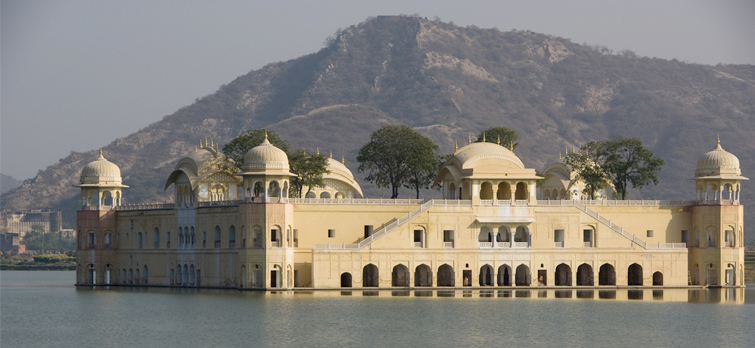
Located in the midst of the Man Sagar Lake, the Jal Mahal is another beautiful example of exquisite Rajasthani style of architecture and Islamic style of architecture. Built in the 18th century by Maharaja Jai Singh II of Amber, the Jal Mahal is a five storied red sandstone structure with some beautiful chhattris, intricately decorated rooms, hallways and wall paintings detailing the complex Rajasthani art. The Jal Mahal over the years has gone through several restorations along with lake and the dam nearby. The area surrounding the Jal Mahal holds a large biosphere with the Aravalli range encircling and layered with tropical forest that is a home to varied species of flora and fauna. Tourists visiting the Jal Mahal can take a boat ride in the Man Sagar Lake. The boats here are crafted in typical Rajasthani style.
Other attractions in Jaipur: Albert Hall Museum, Birla Temple and Jantar Mantar
Nearest Railway Station: Jaipur (JP)
Nearest Airport: Sanganeer Airport (JAI) Jaipur (International)
Distance Chart by road:
| From |
Via |
Distance in Kms. (appx) |
| Kota |
RJ SH 70 – NH 12 |
248 |
| Ajmer |
NH 79 |
131 |
| Udaipur |
Ajmer-Jaipur Exp Way |
420 |
| Jodhpur |
NH 112 – NH 8 |
338 |
| Jaisalmer |
NH 15 – Waterworks Rd. |
570 |
| Agra |
NH 11 |
235 |
| Delhi |
NH 8 |
274 |
7. Laxmangarh Fort, Shekhawati
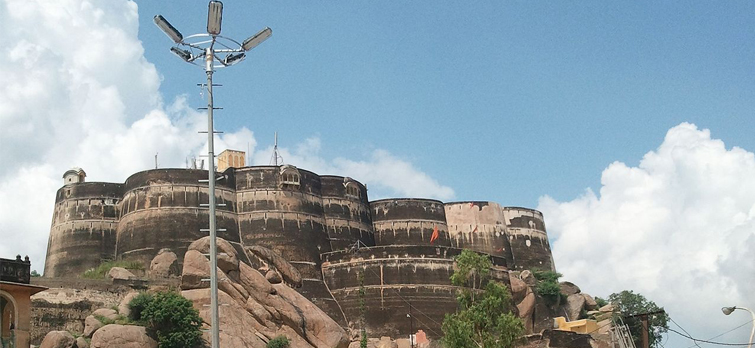
One of the most imposing structures in the town of Laxmangarh, the Laxmangarh Fort is today a privately owned property and hence the entire fort is not open to tourists anymore. The fort was built in the 19th century by Rao Raja of Sikar, Laxman Singh. The unique feature of this fort is that the fort is built upon scattered pieces of huge rocks. Though visits to this fort are not permitted, tourists can still visit the temple and the Char Chowk Haveli nearby.
8. Mandawa Fort, Shekhawati
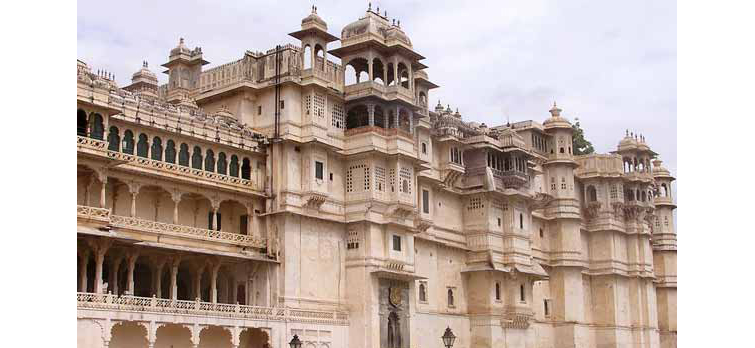
Unfolding some of the unique features of Rajasthani architecture, the Mandawa Fort is notable for its painted archways, paintings and mirror works. Built by Nawal Singh in the 18th century… the exquisite architectural work takes you back to the medieval era. It maintains a palace that houses several antiques. Today, the Mandawa Fort is one of the heritage hotels in Rajasthan.
9. Ratangarh Fort, Shekhawati
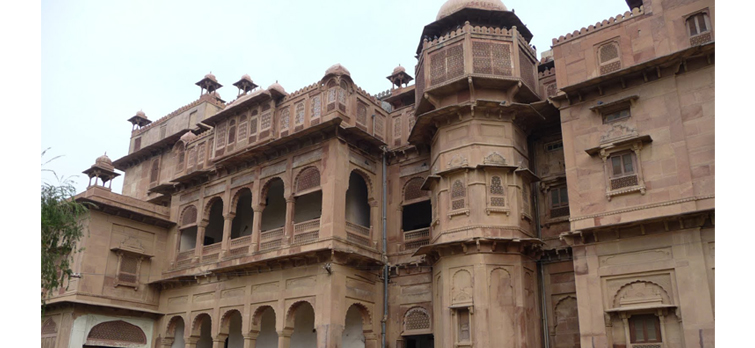
Located on the Agra-Bikaner Highway, the Ratangarh Fort was built in the early 19th century by Ratan Singh and boasts imposing gateways, several monuments (which are mostly in ruins today) and a clock tower, which is also known as Ghantaghar. The Ratangarh Fort makes for a lovely halt on your drive to Bikaner city. Surrounding the fort you can also visit several ancient villages to blend with the typical Rajasthani culture.
Other attractions in Shekhawati: Hanuman Prasad Goenka Haveli, Goenka Double Haveli, Murmuria Haveli, Jhunjhunwala Haveli, Mohal Lal Saraf Haveli, Gulab Rai Ladia Haveli, Thakurji Temple, Stepwells and Cenotaphs and attractions in Jaipur
Nearest Railway Station: Jaipur (JP)
Nearest Airport: Sanganeer Airport (JAI) Jaipur (International)
Distance Chart:
| From |
Via |
Distance in Kms. (appx) |
| Kota |
RJ SH 70 – NH 12 |
245 |
| Ajmer |
NH 79 |
131 |
| Udaipur |
NH 79 – NH 8 |
419 |
| Jodhpur |
NH 112 |
338 |
| Jaisalmer |
NH 15 – RJ SH 7 – RJ SH 2 |
569 |
| Bikaner |
NH 11 |
338 |
| Agra |
NH 11 |
372 |
| Delhi |
NH 8 |
281 |
10. Lohagarh Fort, Bharatpur
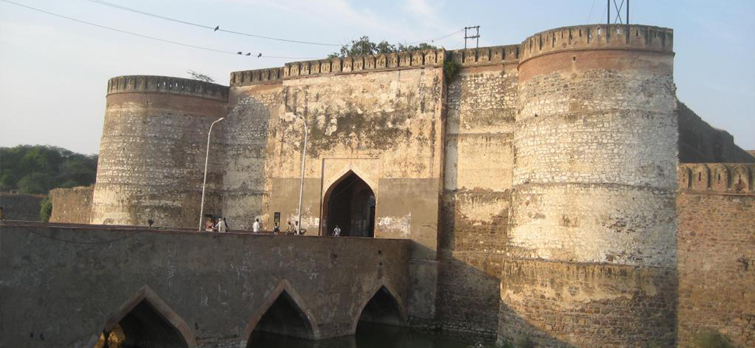
Located in the heart of Bharatpur town on an artificial island, the Lohagarh Fort is said to be the only “pride of India” that has able to defend the attacks of the Mughals and Britishers in the mid 18th century and early 19th century respectively. True to its name the fort was one of the strongest ever structures built in Indian history. The construction work was started in 1732 by the Jat ruler Maharaja Suraj Mal and was completed after 60 years. Each and every part of the fort has a story to tell. The Ashtadhatu Gate, which is the main entrance, and Lohiya Gate are made out of different metals, which were brought back from Delhi after the Jats won over the Delhi Sultanate. Originally the Ashtadhatu Gate, which is made up of eight different metals, used to be the gate of Chittorgarh Fort. It was carried to Delhi by Sultan Alauddin Khilji after he defeated the Rajputs in the 13th century.
The Lohargarh Fort still sits strong with its imposing ramparts and within it looms the Jawahar Burj and Fateh Burj, two victory towers that commemorates the victory over the Mughals and British army. There are three palaces – Mahal Khas, Kamra Palace and Badan Singh’s Palace – of which the Badan Singh’s Palace is the oldest one built by Suraj Mal’s father. The Kamra Palace and the hall of Badan Singh’s Palace were converted into State Archeological Museum in 1944 and now houses a fine collection of antiques excavated from nearby villages like Noh, Mailah, Bureh and Bayana… which belong to the Kushana period. The museum also stores some Arabic and Sanskrit manuscripts, armours and paintings.
The Mahal Khas on the other hand is an excellent example of the Jat architectural style holding carved roofs, marble floor, and beautiful wall paintings. Some other interesting structures within the fort are the Iron Pillar, Ganga Mata Temple, and Laxman Temple. After getting hold of the rich history of Lohagarh Fort and its impressive monuments, tourists can spend some hours idling at the Nehru Park, which lies between the Museum and Ashtadhatu Gate. The Lohagarh Fort is one of the must visit forts in Rajasthan, which holds the heroic days of the Jat rulers.
11. Deeg Palace, Bharatpur
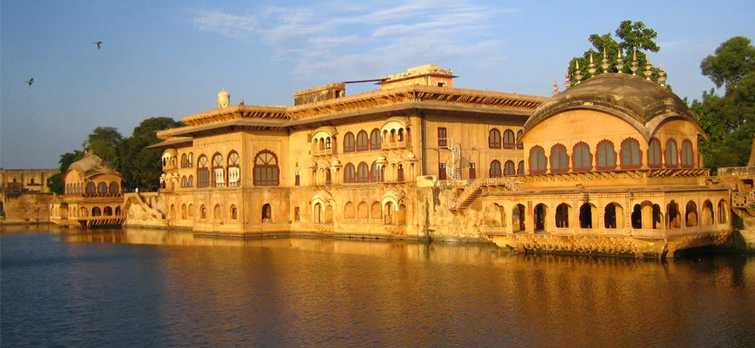
Built in 1772 by the Jat rulers as a luxurious summer resort, the Deeg Palace is another beautiful architectural specimen that reflects the typical Mughal style of architecture. It is crafted with many princely slated rooms, carved gates and windows having stone slabs, ornate beams and marble jalis. It also houses a pavilion, Keshav Bhawan, which maintains a canal with several fountains. It is one of the must visit places in Rajasthan after your sightseeing in Bharatpur, which includes the Bharatpur Bird Sanctuary and Lohagarh Fort.
Other attractions in and around Bharatpur: Bharatpur Bird Sanctuary, Keoladeo National Park, Fatehpur Sikri, Taj Mahal and Agra Fort
Nearest Railway Station: Bharatpur Junction (BTE)
Nearest Airport: Sanganeer Airport (JAI) Jaipur and Indira Gandhi International Aiport, New Delhi
Distance Chart by road:
| From |
Via |
Distance in Kms. (appx) |
| Kota |
RJ SH 70 – RJ SH 1 |
330 |
| Ajmer |
NH 11 |
321 |
| Jaipur |
NH 11 |
186 |
| Udaipur |
RJ SH 32 – NH 79 – NH 11 |
609 |
| Jodhpur |
NH 112 |
528 |
| Jaisalmer |
NH 15- RJ SH 19 – RJ SH 43 |
777 |
| Agra |
Fatehpur Sikri Road |
55 |
| Delhi |
Yamuna Exp Way – SH 80 |
197 |
12. Ranthambore Fort, Sawai Madhopur
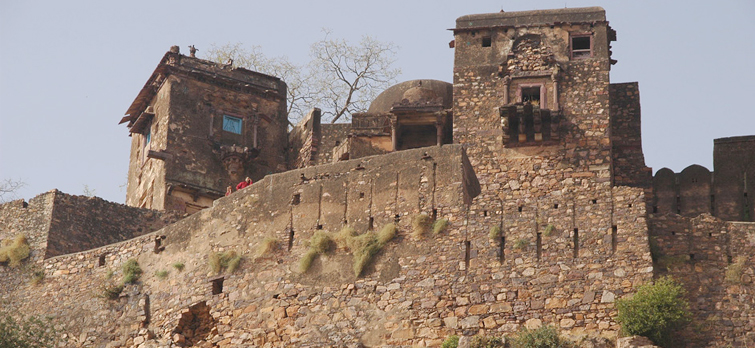
Tucked in the midst of nature the Ranthambore Fort is a popular tourist attraction in Rajasthan and a must visit place for travellers going for a wildlife safari in Ranthambore National Park. Yes! The Ranthambore Fort is a part of the Ranthambore National Park, which is home to several endangered animals and birds including the Royal Bengal Tiger. Built in the 10 century by the Nagil Jats, who were the descendants of Nagavanshi Mahapurusha Nagavaloka… the Ranthambore Fort was later occupied by the Chauhan dynasty. The fort witnessed several attacks by the Sultans of Delhi and the Kings of Mewar and the Mughals. The fort complex still sits with several architectural structures including palaces and temples of which the Jogi Mahal, Ganesha Temple, Shiva Temple, Ramlalji Temple and temple of Lord Sumatinath and Lord Sambhavanath are the major attractions.
Nearby Tourist Attractions: Ranthambore National Park, Kachida Valley, Surwal Lake, Malik Talao, Padam Talao, Raj Bagh Ruins and Ranthambore School of Arts.
Nearest Railway Station: Sawai Madhopur (SWM)
Nearest Airport: Sanganeer Airport (JAI) Jaipur (International)
Distance Chart:
| From |
Via |
Distance in Kms. (appx) |
| Kota |
Siwar Bagina Sawai Madhopur Shyampura Bhureri Phari |
145 |
| Ajmer |
NH 79 – RJ SH 24 |
266 |
| Jaipur |
NH 11 C – NH 11 |
150 |
| Udaipur |
NH 76 |
398 |
| Agra |
SH 39- RJ SHI 1 |
260 |
| Delhi |
NH 8 – RJ SH 25 |
377 |
| Gwalior |
NH 3 – NH 11B |
281 |
| Bharatpur |
NH 11 – RJ SH 1 |
202 |
13. Chhattar Mahal or Palace of Towers, Bundi
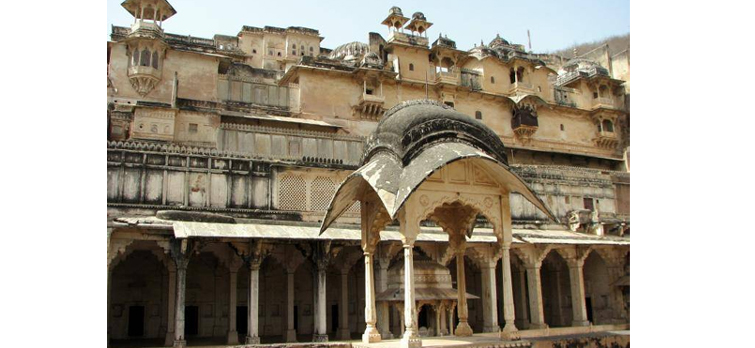
Tucked on a hillside, this palatial architecture in Bundi can only be accessed through a sharp inclined paved pathway. The palace comprises two major gates – the Hazari Pol or Gate of the thousand, and Hathi Pol having an old water clock. It also holds a pavilion – the Naubat Khana, and a public audience hall – the Diwan-e-Aam. It is one of the major heritage attractions in Bundi.
14. Taragarh Fort, Bundi
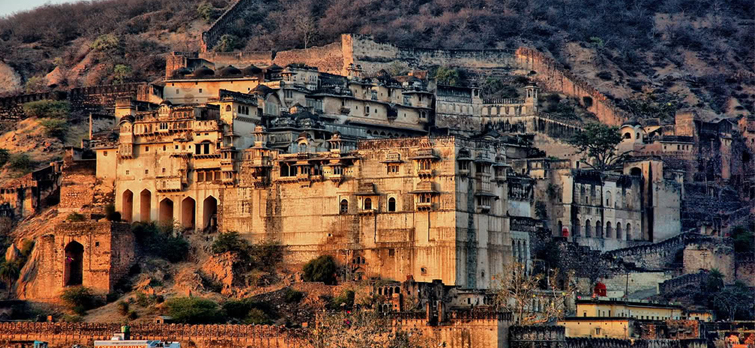
Overlooking the city of Bundi, this impressive structure stands tall on a steep hillside. Built in 1354 with three gateways – Lakshmi Pol, Phuta Darwaza and Gagudi Ki Phatak – which are mostly in ruins today, the Taragarh Fort… though it has lost much of its sheen with time, it still continues to amaze the tourists with a rich diorama of the erstwhile Chauhan dynasty. The fort was crafted with an excellent network of tunnels crisscrossing the entire hill side but it is inaccessible to tourists for want of proper maps. The fort comprises huge water reservoirs, a small palace with some marvelous murals and stained glass and a tomb that is known as “Miran Saheb Ki Dargah”.
Nearby Tourist Attractions: Bundi Palace, Shikar Burj, Jait Sagar, Stepwells, Phool Sagar, Dugari Fort and Ramgarh
Nearest Railway Station: Bundi Railway Station (BUDI) and Kota Junction (KOTA)
Nearest Airport: Sanganeer Airport (JAI) Jaipur
Distance chart by road:
| From |
Via |
Distance in Kms. (appx) |
| Kota |
RJ SH 70 |
40 |
| Ajmer |
NH 79 – RJ SH 26 – NH 12 |
176 |
| Jaipur |
NH 12 – RJ SH 29 – RJ SH 70 |
210 |
| Udaipur |
NH 76 – RJ SH 29 – RJ SH 70 |
270 |
| Jodhpur |
NH 112 – NH 12 – RJ SH 39 |
345 |
| Jaisalmer |
NH 15 – NH 112 – RJ SH 29/70 |
635 |
15. Vinay Vilas Mahal, Alwar
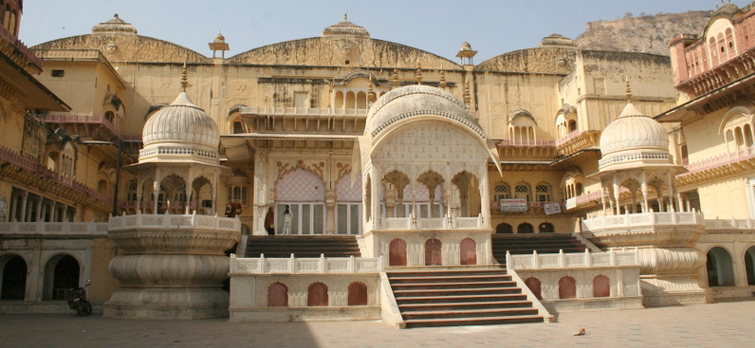
A historical landmark in the heart of the town, the Vinay Vilas Mahal is yet another marvelous structure displaying a rich blend of Rajput and Mughal architecture. It was built in 1815 by Maharaja Vinay Singh and is crafted with elegant rooms, carved windows, facades and hallways. It also houses a cenotaph that holds an intricately carved roof and arches. Today, the Vinay Vilas Mahal is one of the best tourist places in Alwar that maintains a well stocked museum with a rich collection of antiques, manuscripts, miniature and paintings.
Nearby Tourist Attractions:
Nearest Railway Station: Bundi Railway Station (BUDI) and Kota Junction (KOTA)
Nearest Airport: Sanganeer Airport (JAI) Jaipur
F12″>Distance chart by road:
| From |
Via |
Distance in Kms. (appx) |
| Kota |
RJ SH 70 – RJ SH 24 – NH 11 A |
340 |
| Jaipur |
NH 8 – RJ SH 13 |
150 |
| Delhi |
NH 8 – RJ SH 25 |
169 |
16. Junagarh Fort, Bikaner
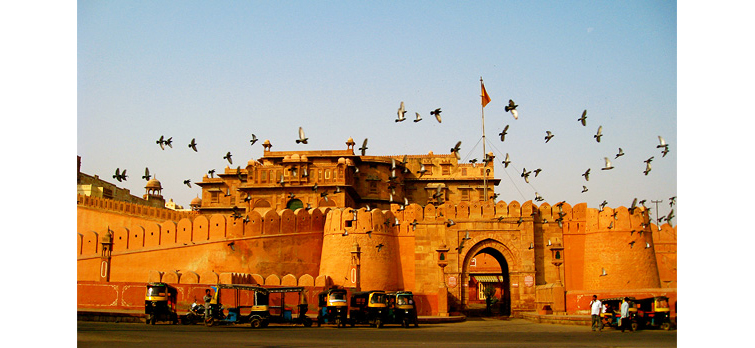
One of the prominent landmarks in the heart of Bikaner city, the Junagarh Fort is an outstanding example of art, architecture and culture. The composite structure with several palaces, temples and mansions holds a fusion of Mughal, British and Rajasthani style of architecture. Within the baronial fort walls lies the ruins of the old stone fort that was built in 1478 by Maharaja Rao Bika, one of the Rathore clans. Later, under the administration of Raja Rai Singhji, who was an esteemed army general in the court of Emperor Akbar and his son Emperor Jahangir, the construction of the Junagarh Fort was started in 1589 and was completed in 1594. The fort comprises several monuments that reflect the typical Mughal architectural style, the most impressive being the Phool Mahal, which is the oldest part of the fort.
The Karan Mahal that was built in 1680 by Karan Singh signifies the victory over the Mughal Emperor Aurangazeb and holds some exquisite artistic work that includes stained glass windows, intricately carved balconies built in stone, wood fluted columns, inlaid polychrome glass, mirrors and a coronation chamber. The Anup Mahal, which is a multi-storey structure with ornate wooden ceilings and houses the public audience hall, and princely slated rooms is one of the grandest construction works by Anup Singh, who ruled from 1669-98. He also established the royal Zenana quarter for females. The Chandra Mahal built in the late 18th century by Gaj Singh and Ganga Mahal which was built by Ganga Singh in the 20th century are the two other impressive structures detailing the typical Rajasthani style of architecture with royal bedrooms, durbar hall, gold plated deities and paintings adorned with precious stones.
Some other elegant architectural work are reflected from the Har Mandir, Karan Pol, Suraj Pol, Chand Pol and Fateh Pol. The intricately carved Jain temples and havelis within the rampart are the other tourist attractions in Bikaner.
17. Lalgarh Palace, Bikaner
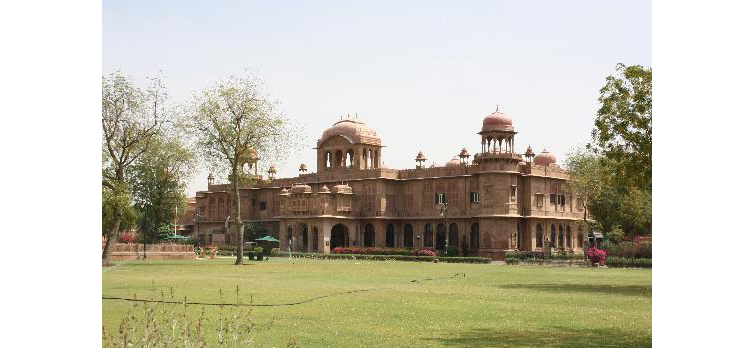
It is one of the elegant palatial buildings in Bikaner and was built in between 1902 and 1926 highlighting the Indo-Saracenic style of architecture. It is only a few kilometers from the Junagarh Fort and is crafted with several wings – one is occupied by the royal family and others are converted into a museum (Shri Sadul Museum, which is one of the best museums in India), Lallgarh Palace Hotel, which is yet another heritage hotel in Rajasthan and the Laxmi Niwas Palace, which is one of the luxury hotels in India.
Nearby Tourist Attractions: Laxmi Niwas Palace, Lalgarh Palace, Maru Nayak Ji Temple, Laxmi Nath temple, Bhandasar Temple, Mukam Temple, Karni Mata Temple, Havelis and other villages.
Nearest Railway Station: Bikaner Junction (BKN)
Nearest Airport: Jodhpur Airport (Delhi/Mumbai) and Sanganeer Airport (JAI) Jaipur (International)
Distance Chart by road:
| From |
Via |
Distance in Kms. (appx) |
| Kota |
NH 12 – RJ SH 39 – NH 89 |
507 |
| Ajmer |
NH 79 – NH 89 |
267 |
| Jaipur |
NH 11 |
334 |
| Udaipur |
NH 158 – NH 89 |
488 |
| Jodhpur |
NH 65 – NH 89 |
252 |
| Jaisalmer |
NH 15 |
330 |
| Agra |
NH 11 |
580 |
| Delhi |
NH 8 – RJ SH 13 – NH 11 |
448 |
18. Jaisalmer Fort or Sonar Quilla, Jaisalmer
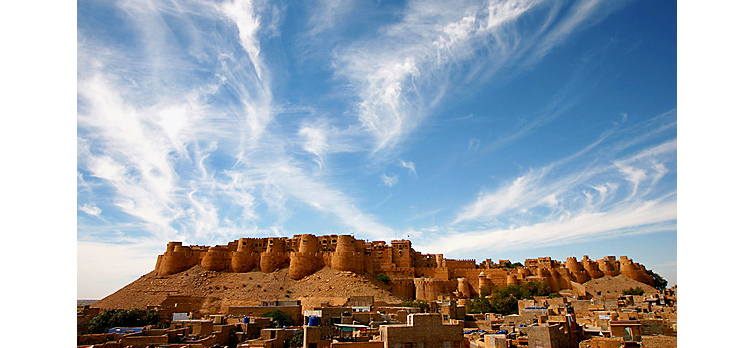
Built in the mid of 12th century by Rawal Jaisal, the massive fortification overlooking the Jaisalmer city amid the Thar Desert is one of the largest fortifications in the world. The Jaisalmer Fort, which is often dubbed as Sonar Quila, is a yellow sandstone architecture that is rimmed with 3 layers of walls and maintains 99 bastions, two major cannon points and several architectural structures including the Royal Palace, four massive gateways, merchant havelis and temples belonging to both the Hindu and Jain religion. The Shree Nath Palace and Vyas Haveli are some of the popular tourist attractions inside the Jaisalmer Fort. There is also a museum that exhibits a fine collection of armours, portraits and paintings dilating the heroic period of the Rajput clans. At the entrance of the fort there is a small market where you can shop some Rajasthani traditional attires.
There are innumerous hotels, eateries and restaurants where tourists can try out typical Rajasthani cuisine and other Indian and international delicacies. The Jaisalmer Fort is one of the major heritage sites in India that is listed by UNESCO and over the years it has been able to attract tourists from all over the world. Besides its history and architectural works… the amazing view of the Jaisalmer City from the canon points and horizon at the sunset are major tourist attractions.
Nearby Tourist Attractions: SAM Sand Dunes, Kuldhara Village, Bada Bagh, Gadi Sagar Lake, Salim Singh Ki Haveli, Patwa Ki Haveli, Mandir Palace and Khaba Fort
Nearest Railway Station: Jaisalmer Railway Station (JSM)
Nearest Airport: Jodhpur Airport (Delhi/Mumbai)
Distance Chart:
| From |
Via |
Distance in Kms. (appx) |
| Kota |
NH 12 – NH 112 |
672 |
| Ajmer |
NH 79 – NH 65 – NH 15 |
462 |
| Jaipur |
Jaipur-Ajmer Exp Way – RJ SH 7 – NH 15 |
570 |
| Udaipur |
RJ SH 32 – RJ SH 16 – NH 15 |
505 |
| Jodhpur |
NH 114 – NH 15 |
278 |
19. Mehrangarh Fort, Jodhpur
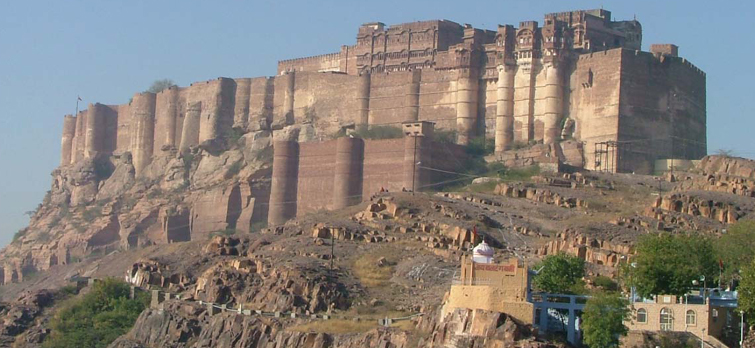
The Mehrangarh Fort is one of the important historical sites in India which has witnessed several battles against the Jaipur and Bikaner army. The foundation stone of this imposing fort was laid atop a hill by the Rathore ruler Rao Jodha with the help of Rao Nara in 1459. Later it was extended by Jaswant Singh, who ruled between 1638 and 78. The fort is ramped up with a series of seven gates including Jayapol which commemorates the victories over Jaipur and Bikaner armies; Fattehpol which marks the defeat of the Mughals; Dedh Kamgra Pol; and Loha Pol hold an important place in the history of Rajasthan.
Close to the Loha Pol you can still witness several palm imprints of the ranis who willingly cremated themselves on the funeral pyre of their dead husband, Maharaja Man Singh. Within the fort complex you will also come across some of the best palaces of Rajasthan – Moti Mahal, Phool Mahal, Sheesh Mahal, Sileh Khana and Daulat Khana which are notable for having exquisite architectural works with intricate carvings and expansive courtyards. Most of these palaces today together comprise a museum that displays a vast collection of palanquins, howdahs, royal cradles, miniatures, musical instruments, costumes and furniture. It also hosts several galleries housing antiques belonging to the Mughal emperors, armours belonging to several Rajput clans, and turbans. The fort complex also holds a temple, cenotaphs and canons.
20. Umaid Bhawan Palace, Jodhpur
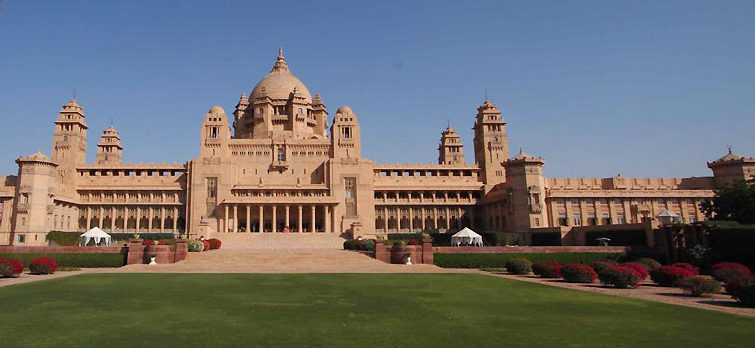
Guess what!!! The Umaid Bhawan Palace in Jodhpur is one of the world’s largest residences and was built in the early 20th century by Maharana Umaid Singh. It took approximately 15 years to complete the entire construction work, which now comprises of 347 rooms. Today, a part of it serves as a museum (open for tourists) and heritage hotel that is maintained by the Taj Group of hotels, resorts and palaces. Most part of the palace is still occupied by the royal family. It also hosts a gallery showcasing the most exotic automobiles owned by the maharajas.
Nearby Tourist Attractions: Jaswant Thada, Mandore, Balsamand Lake, Kaylana Lake, Ghanta Ghar, Gangaur and Umaid Bhavan Palace.
Nearest Railway Station: Jodhpur Junction (JU)
Nearest Airport: Jodhpur Airport (Delhi/Mumbai)
Distance Chart:
| From |
Via |
Distance in Kms. (appx) |
| Kota |
NH 12 – NH 116A – NH 112 – Dangiyawas Bypass |
382 |
| Ajmer |
NH 79 – NH 112 – Dangiyawas Bypass |
207 |
| Jaipur |
NH 8 – NH 112 – Dangiyawas Bypass |
338 |
| Udaipur |
RJ SH 50 – RJ SH 61 |
257 |
| Jaisalmer |
NH 15 – NH 114 |
278 |
21. Chittaur Fort, Chittaurgarh
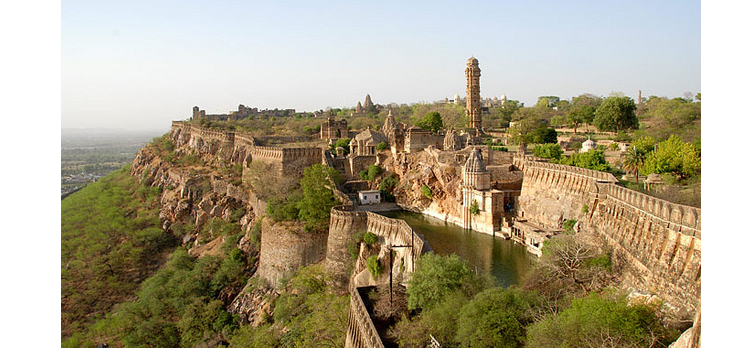
One of the oldest forts in Rajasthan that was built in the 7th century during the Mauryan period… the Chittor Fort is yet another magnificent architecture that arrests the eyes of travellers from all over the world. It is a UNESCO World Heritage Site in India that is ramped up on a hilltop spreading over an area of 692 acres and unfolds the chivalrous history of the Mewar rulers of Sisodia. The fort is studded with several majestic palaces, baronial gates, intricately designed temples and two memorials. It also boasts of several step wells, paintings, and other artistic works. With the passage of time the Chittor Fort has been witness to several battles, of which the Mewar Kings against Allauddin Khilji in 1303, Rana Sanga against Mughal Emperor Babur in 1527, Bikramjeet Singh against Bahadur Shah in 1535, and Maharana Udai Singh II against the Mughal Emperor Akbar in 1567 (final siege) holds an important place in the royal history of Rajasthan.
The fort complex comprises approximately 65 historic structures. The seven massive stone gates – Padan Pol, Bhairon Pol, Hanuman Pol, Ganesh Pol, Jodia Pol, Laxman Pol and Ram Pol (the main gate); palaces include the Rana Kumbha Mahal, Kanwar Pade Ka Mahal, Ratan Singh’s Palace, Badal Mahal and the beautiful Padmini’s Palace, which is one of the must visit palaces in Rajasthan; memorials such as Vijay Stambha and Kirti Stambha and several cenotaphs; and ancient temples dedicated to Hindus and Jains like Kalika Mata Temple, Kshemankari Temple, Kumbha Shyam Temple, Adbuthnath Temple, Shringar Chawri and Sat Bis Devri are the most intensifying structures in the fort complex that holds the incredible part of the Rajasthan Tourism.
22. Rani Padmini’s Palace, Chittaurgarh
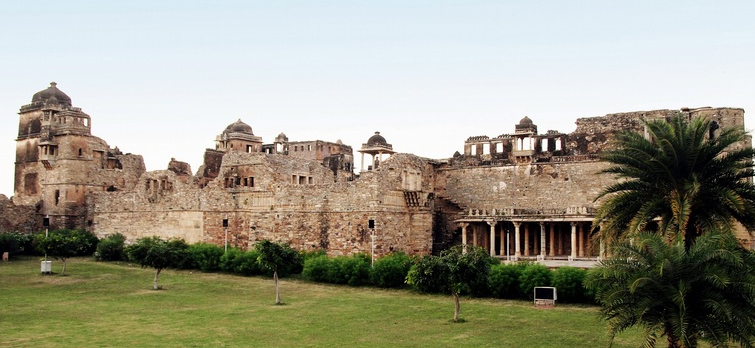
The Rani Padmini’s Palace is one of the beautiful palaces in India that is placed inside the massive fort of Chittorgarh. The stunning architectural style of this palace and its picturesque surrounding simply catches the imagination of the travellers. Rani Padmini, the second wife of the brave and noble king of Mewar, Rawal Ratan Singh, used to reside in this palace. Rani Padmini’s self immolation during the attack of Alauddin Khilji in the 13th century makes the palace historically significant. Today it is a famous tourist spot in Rajasthan and it stands as a feminine structure engulfed by a cascade of water, which at one point of time might have reflected the grace, gallantry, strength and spruce of the queen.
Nearby Tourist Attractions: Rani Padmini’s Palace, Rana Kumbha’s Palace, Kirt Stambh, Vijay Stambh and Udaipur city
Nearest Railway Station: Chittaurgarh (COR) and Udaipur City (UDZ)
Nearest Airport: Dabok Airport, Udaipur
Distance Chart by road:
| From |
Via |
Distance in Kms. (appx) |
| Kota |
RJ SH 70 – RJ SH 33 |
174 |
| Ajmer |
NH 79 |
197 |
| Jaipur |
NH 79 |
308 |
| Udaipur |
NH 76 |
121 |
| Jodhpur |
RJ SH 61 – NH 79 |
303 |
| Jaisalmer |
NH 112 – RJ SH 61 – NH 79 |
572 |
23. Kumbalgarh Fort, Kumbalgarh
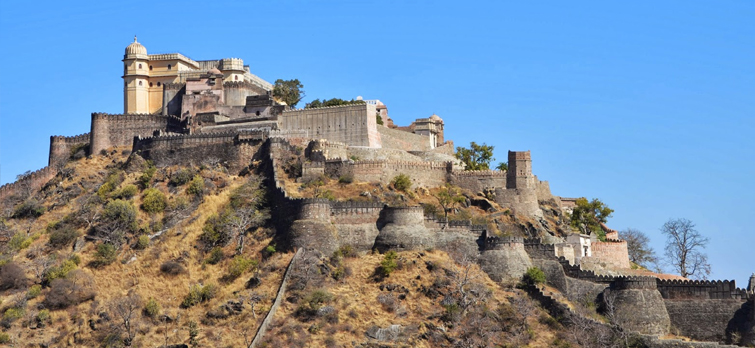
Having a vast history… the Kumbhalgarh Fort is one of the significant heritage sites in Rajasthan widely known for its serpentine 36 kilometers long wall comprising seven huge imposing gates – Hulla Pol, Hanuman Pol, Ram Pol, Bhairava Pol, Paghra Pol, Top-khana Pol and Nimboo Pol which are bolstered by watch towers and bastions. It was built in the 15th century atop the Aravalli Mountains by Maharana Rana Kumbha. Within the fortification… there are several palaces and more than 300 temples, of which the Badal Mahal (birth place of Maharana Pratap) holds a strong place in the history of Rajasthan. The Shiva Temple is yet another beautiful work of architecture that is worth visiting.
Nearby Tourist Attractions: Attractions in Udaipur
Nearest Railway Station: Falna Railway Station (FA)
Nearest Airport: Dabok Airport, Udaipur
Distance Chart by road:
| From |
Via |
Distance in Kms. (appx) |
| Kota |
NH 76 – NH 76 B |
295 |
| Ajmer |
NH 79 – RJ SH 16 |
214 |
| Jaipur |
NH 8 – NH 162 Ext |
344 |
| Udaipur |
NH 927 A |
99 |
| Jodhpur |
RJ SH 61 – RJ SH 67 |
181 |
| Jaisalmer |
NH 15 – RJ SH 16 – NH 162 Ext |
430 |
24. City Palace, Udaipur
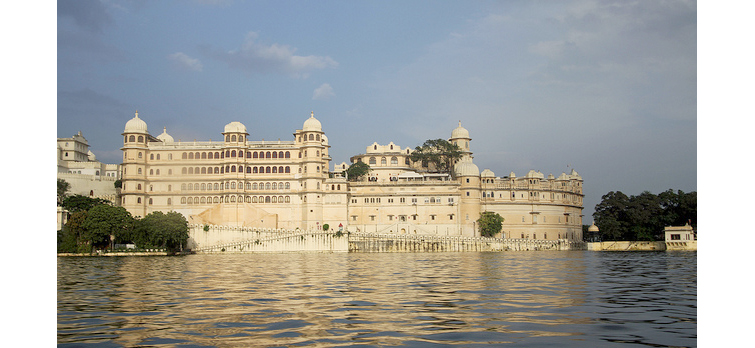
An outstanding example of an elegant architectural work with a rich blend of Rajasthani, Mughal, European and Chinese architecture… the City Palace in Udaipur is regarded as one of the beautiful palaces in Rajasthan. This palatial complex was built in the mid of the 16th century by Maharana Udai Singh, who shifted his capital from Chittor. Over the years the palace got extended by the successors and today it holds a complex structure with 11 small separate palaces, gateways, balconies, towers, gardens and cupolas that exhibit delicate mirror-work, marble-work, murals, wall paintings, silver-work, inlay-work and leftover of colored glass. The major attractions in the complex are the gateways – Bari Pol, Tripolia and Hathi Pol; palaces – Dilkhush Mahal, Sheesh Mahal, Moti Mahal and Badi Mahal; chambers – Krishna Vilas, Bhim Vilas and Amar Vilas; and other attractions like Suraj Gokhda OR public address facade, Mor-chowk, and Surya Chopar. The Shambu Niwas, which still belongs to the royal family, and the Fateprakash Palace and Shiv Niwas Palace, which were added later to the complex, are the two heritage hotels in Rajasthan which are located inside the complex. Some other tourist attractions inside the City Palace are the museum and temples of Lord Krishna, Lord Shiva and Meera Bai.
25. Lake Palace, Udaipur
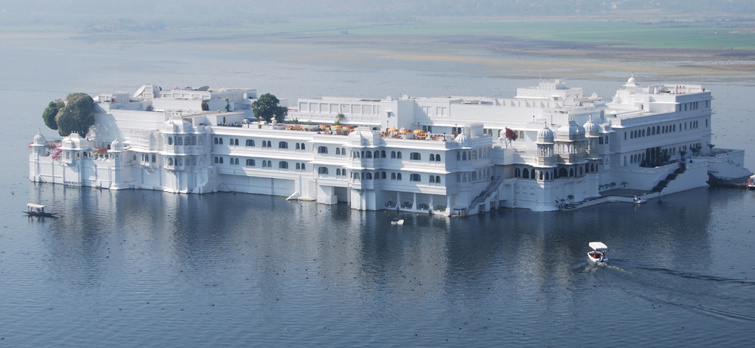
In the middle of Lake Pichola and overlooking Udaipur City, Lake Palace which was formerly known as Jagniwas is a fine marble masterpiece that was built between 1743 and 1746 by Maharana Jagat Singh II. It was also a shelter of the British army during the Indian Sepoy Mutiny in 1857. Today it is one of the major tourist attractions in Udaipur and plays a significant role in the tourism and hospitality industry in India. In 1971 this palatial property was taken over by the Taj Group of Hotels, Resorts and Palaces and thereafter the restoration of the original property presented the contemporary shape with exquisitely designed 83 rooms offering a royal touch, restaurants, recreational centers, pools and business centers. Today it has been extolled as the most romantic luxury hotel in India and in the world due to its scenic location with the Aravali mountains at the backdrop, pleasing ambiance and cordial reception.
26. Monsoon Palace, Udaipur
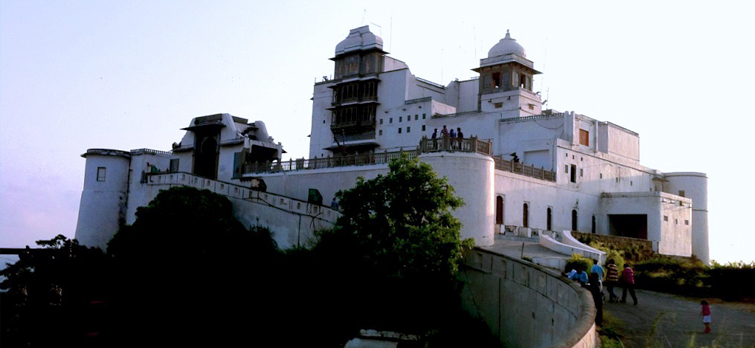
It is one of the most visited palatial buildings in Rajasthan that is tucked high in the Aravalli Hills and overlooking the lake Fateh Sagar. Built in 1884 by Maharana Sajjan Singh of the Mewar Dynasty and later extended by Maharana Fateh Singh, the Monsoon Palace is an excellent craftsmanship of marble and masonry. It is beautifully crafted with high turrets, exquisitely shaped facades, intricately designed marble pillars, adorned rooms and quarters and a spacious court. It also presents a composite picture of Rajasthani style of architecture with domes, fountains and jharokas. Originally the Monsoon Palace was built as an astronomical center that would keep track of the movement of monsoon clouds in the surrounding area.
Other attractions in and around Udaipur: Saheliyon-ki-Bari, Jag Mandir, Jagdish Temple, Moti Magri and Mount Abu
Nearest Railway Station: Udaipur City (UDZ)
Nearest Airport: Dabok Airport
Distance Chart by road:
| From |
Via |
Distance in Kms. (appx) |
| Kota |
NH 76 |
288 |
| Ajmer |
NH 8 |
270 |
| Jodhpur |
RJ SH 32 |
258 |
| Jaisalmer |
NH 15 |
507 |
| Jaipur |
NH 8 |
419 |
| Ahmedabad |
NH 8 |
256 |
27. City Palace, Banswara
It is a 16th century palace which sprawls over a large area and is a unique example of old Rajput architecture. The City Palace overlooking the town is still owned by the royal family and can be visited only on invitation.
Nearest Railway Station: Udaipur City (UDZ)
Nearest Airport: Dabok Airport
Distance Chart by road:
| From |
Via |
Distance in Kms. (appx) |
| Udaipur |
RJ SH 32 |
165 |
| Jodhpur |
RJ SH 32 |
419 |
| Kota |
RJ SH 70 – NH 113 |
365 |
| Ahmedabad |
NH 8 |
279 |
28. Udai Bilas Palace, Dungarpur
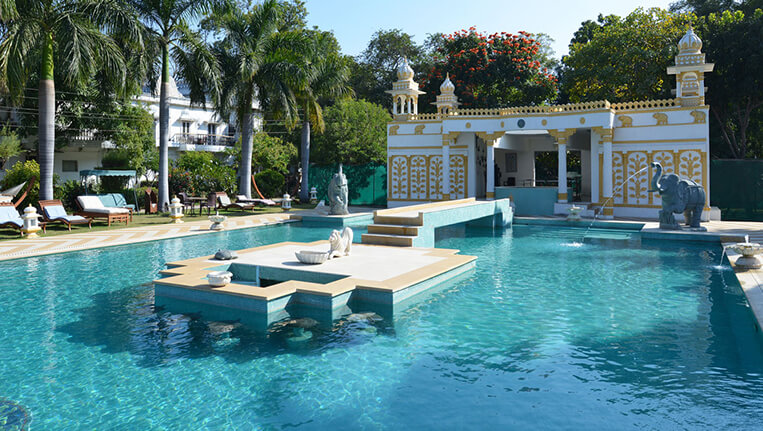
It is a 19th century palace that is surrounded by the Aravalli mountains and overlooks the Gaib Sagar Lake… thus making Udai Bilas Palace one of the picturesque palatial building in Rajasthan. It was built in buish-grey sandstone by Maha Rawal Udai Singhji and today it is one of the heritage hotels in India that is crafted with 20 elegant rooms offering an intense traditional and royal atmosphere.
29. Juna Mahal, Dungarpur
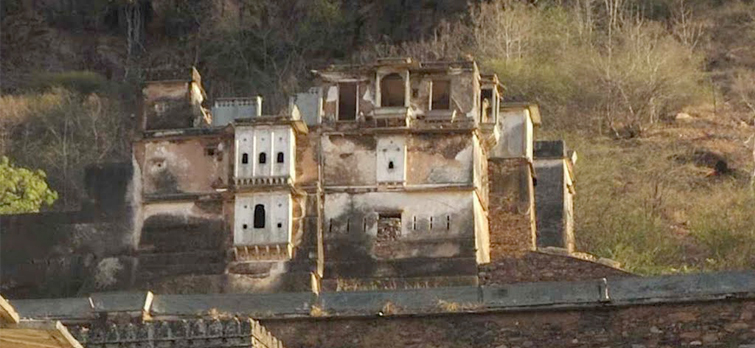
Crafted with several wings, the Juna Mahal is a beautiful example of Rajasthani style of architecture having carved windows and gates, glass and wall paintings elaborating the Mewari style of architecture and articulately paved rooms. The initial construction work was started in the 13th century by Rawal Veer Singh Deo and was completed in the 18th century.
Nearest Railway Station: Udaipur City (UDZ)
Nearest Airport: Dabok Airport
Distance Chart by road:
| From |
Via |
Distance in Kms. (appx) |
| Udaipur |
RJ SH 32 |
105 |
| Ahmedabad |
NH 8 |
173 |
30. Gagron Fort, Jhalawar
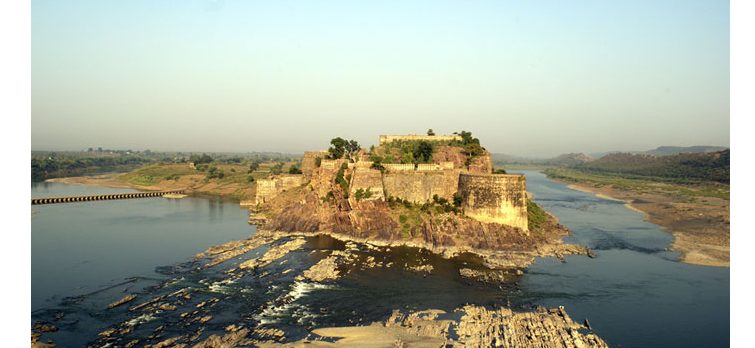
Turned into a government edifice, this palatial building used to be the residence of Maharaja Madan Singh. It was built in between 1840 – 1845 and holds some beautiful paintings, and frescoes on both walls and mirrors.
Nearest Railway Station: Jhalawar Railway Station and Kota Junction
Nearest Airport: Sanganeer Airport (JAI) Jaipur (International)
Distance Chart by road:
| From |
Via |
Distance in Kms. (appx) |
| Jaipur |
NH 12 |
329 |
| Kota |
NH 12 |
86 |
| Udaipur |
RJ SH 50 – NH 79 |
317 |
“Finally it’s time to boot up for a heritage tourism in Rajasthan. Tour My India is just a click away from your travel door. We offer Rajasthan tour packages both for luxury and budget travellers. With us you can explore the erstwhile forts and palaces of Rajasthan, incredible wildlife, temples, shopping markets and much more. Send us requirements at info@tourmyindia.com and our expert will get back to you within 5-4 hours. You may also check out our other customized travel packages for India.”
Published: 25 Sep, 2014
Brought up from the cultural capital of India, Kolkata, Swairik Das is a passionate traveller who seeks to travel and explore the length and breadth of the country. He is also a dedicated travel writer, blogger and photographer who by heart is also an adventure freak. His focus is mostly into exploring and writing on trekking, jungle safaris and several adventure activities; religion, festival, heritage, people and cuisine.



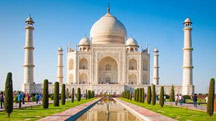 4 Nights / 5 Days
4 Nights / 5 Days 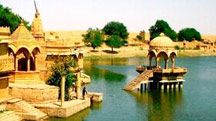 10 Nights / 11 Days
10 Nights / 11 Days 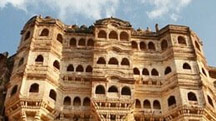 13 Nights / 14 Days
13 Nights / 14 Days 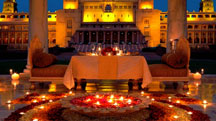 5 Nights / 4 Days
5 Nights / 4 Days 





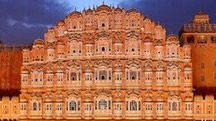 2 Nights / 3 Days
2 Nights / 3 Days 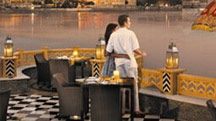 3 Nights / 4 Days
3 Nights / 4 Days 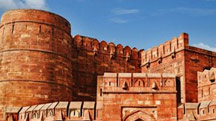 2 Nights / 3 Days
2 Nights / 3 Days 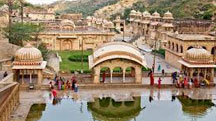 2 Nights / 3 Days
2 Nights / 3 Days 








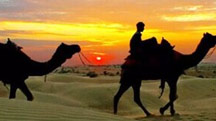 16 Nights / 17 Days
16 Nights / 17 Days 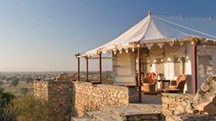 14 Nights / 15 Days
14 Nights / 15 Days 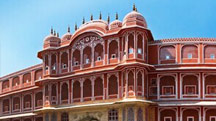 12 Nights / 13 Days
12 Nights / 13 Days 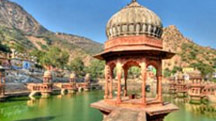 18 Nights / 17 Days
18 Nights / 17 Days 


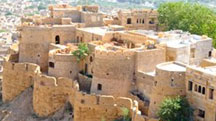 2 Nights / 3 Days
2 Nights / 3 Days  3 Nights / 4 Days
3 Nights / 4 Days 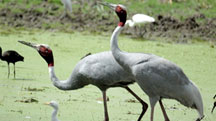 2 Nights / 3 Days
2 Nights / 3 Days 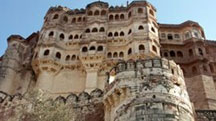 11 Nights / 12 Days
11 Nights / 12 Days 







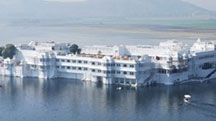 2 Nights / 3 Days
2 Nights / 3 Days 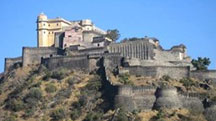 4 Nights / 5 Days
4 Nights / 5 Days 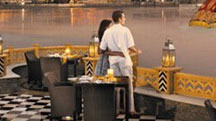 6 Nights / 7 Days
6 Nights / 7 Days 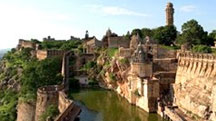 4 Nights / 5 Days
4 Nights / 5 Days 


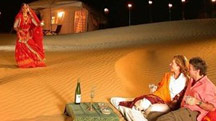 14 Nights / 15 Days
14 Nights / 15 Days 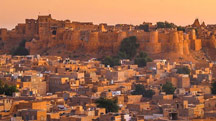 12 Nights / 13 Days
12 Nights / 13 Days 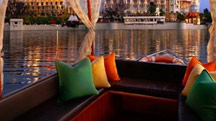 15 Nights / 16 Days
15 Nights / 16 Days  13 Nights / 14 Days
13 Nights / 14 Days 